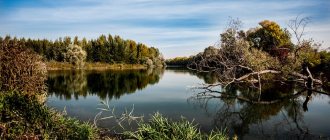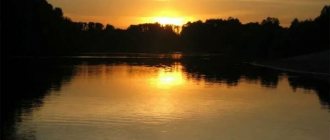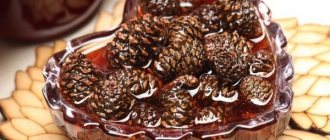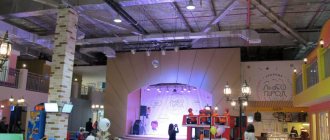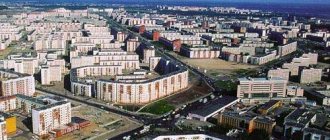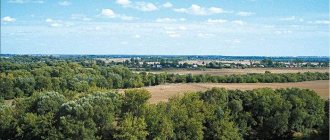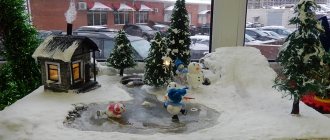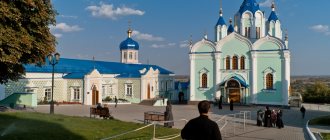The floodplain lakes of the Kursk region, rich in fish and rare species of waterfowl, attract tourists from different parts of Russia. People travel to the reservoirs of the region with a mild climate and a small number of summer rainy days from the capital, St. Petersburg, northern Vologda and Cherepovets. On artificial and natural reservoirs of the Kursk region, vacationers swim, sunbathe, fish, and admire the beauty of southern Russian nature. In a short review we will look at the lakes of Kursk, interesting for their fauna, fish stocks, and beach recreation opportunities.
Oryol Region
Distance from Kursk - 120 kilometers
In the village of Dolbenkino, on the border of the Kursk and Oryol regions, there is a real Old Russian park. The mill, wooden stove, cart, and hut were made with their own hands by local residents - the Bulychev family. They also organized a local history museum, where you can hear about the history of the village, find out what the royal family did here, hear many stories about the local church and much more.
. . .
Rush into the outback
Feeding horses, milking cows, baking real pies in a classic Russian oven - all this is a novelty for a city dweller. Therefore, the Kursk region is also attractive for supporters of the increasingly popular rural tourism. Thus, on the territory of the landscape complex “Khutor Pesochnoye” you can not only enjoy all the delights of peasant life, but also try your hand at traditional handicrafts. Experienced craftsmen will teach you how to make pottery or how to weave on a spinning wheel. By the way, guests are welcome in the Kursk outback both in winter and summer. Whatever the time of year and any weather, a city dweller yearning for his rural roots will find here entertainment to suit his taste.
Bryansk region
Distance from Kursk - 170 kilometers
In the village of Lopandino, on the border of the Oryol, Kursk and Bryansk regions, you can find one of the largest estates in the Black Earth Region. Its owner, a large landowner Maria Voeikova, owned a sugar factory in the Komarichsky district. Voeykova lived 6 kilometers from the plant, in the neighboring village of Radogoshch. It was inconvenient to get there, so the decision was made to build an estate in Lopandino. All this happened at the beginning of the 20th century. The time was approaching revolution. Voeykova, having a presentiment, decided to make the estate strong, high and set up guards in the form of Cossacks. The peasants received little at the factory, and life in the village did not suit them, so they constantly came to her with requests. Maria Vladimirovna fulfilled some of the requests: she raised wages, built new houses for workers, built a school and built a hospital. But the wave of revolution could not be abandoned: the peasants demanded more. By 1917, Voeykova and her family fled to Paris, and her castle passed into Soviet hands. At first there was a school there, then a college, a school, and now the estate is being destroyed and overgrown with grass. And the sugar factory is still operating.
. . .
First person
Alexander Mikhailov, Governor of the Kursk Region
Dear friends!
We often don't notice that we live in an amazing place. It's just how people are made. We always want to visit remote corners of the planet, cities we have never seen before. But to see beautiful and unusual places, you don’t have to travel outside the country. The Kursk region will undoubtedly have attractions that will appeal to avid travelers.
Our region is an ancient and beautiful region with a thousand-year history. Everyone knows about the Kursk nightingale, the fragrant Antonovka, about the Kursk magnetic anomaly, which gives the country iron ore, about the great Battle of Kursk, which largely determined the outcome of World War II.
Article on the topic
Land of traditions. There are a million reasons to come to the ancient Kursk region. Tourists can admire the pristine nature in the Central Black Earth State Nature Reserve named after Professor V. Alekhine, where many rare species of plants and animals have been preserved. By the way, it is part of the system of biosphere reserves of the UNESCO world network.
Our region is rich in cultural heritage, original folk traditions, and interesting creative groups. And now the cultural life of the Kursk region is diverse and very rich. Every year we host such large-scale events as the international festival “Jazz Province”, a music festival of classical performers named after Georgy Sviridov, a festival-competition of young performers “Golden Talents of the Commonwealth”, a festival of bard songs “Nightingale Trill”, games of the Merry and Resourceful Club “Kurskaya” anomaly”, the holiday of friendship and partnership “Kursk Nightingale” and many other cultural events that attract guests from other regions and countries.
At the same time, the Kursk region today is a developed industrial and agricultural region, and at the same time quite environmentally friendly. Kursk chernozems are recognized as the standard of soil fertility; since the last century, their samples have been stored in the Soil Museum in Paris, the Natural History Museum in Amsterdam and the Soil Science Museum near Leipzig. At the same time, there are over four thousand historical and cultural monuments in the region, and tourists’ journey through the main attractions of the region will be bright and unforgettable. I invite everyone who wants to get to know the Kursk region better to visit it.
I am sure that you will fall in love with our ancient and eternally young land, gain confidence in the Kursk people and find true friends among them.
Alexander Mikhailov: “Clinton and Trump care more than the country’s problems” Read more
Belgorod region
Distance from Kursk—120 kilometers
In the village of Alekseevka, Yakovlevsky district, Belgorod region, the house-museum of Mikhail Shchepkin is located. In 1788, when the future actor was born, this village was called Krasny and was part of the Kursk province. Here was the estate of Count Wolkenstein, for whom Misha’s father, Semyon Shchepkin, served as a serf. It was at the Wolkenstein Theater that Shchepkin began his acting career. The museum is open all days from 9-00 to 17-00, except Monday.
. . .
Oryol Region
Distance from Kursk - 120 kilometers
The castle of Vasily Okhotnikov is an unusual building, which is located on the border of the Kursk and Oryol regions in the village of Yakovka. If you have long dreamed of visiting Europe and admiring beautiful architectural structures, this place is especially for you. There was once a sugar factory here, which the landowner built in the 19th century. He traveled a lot in Europe and became imbued with the architecture of those places. There were rumors that in the left tower of the castle, General Okhotnikov held spiritualistic seances and communicated with the souls of his ancestors. The castle is now abandoned.
. . .
Indigenous deserts
Kursk Nativity of the Blessed Virgin Mary of the Hermitage was founded in 1597. at this place in 1295 and a chapel was first built. Several centuries later, by decree of Tsar Fyodor Ioannovich, a monastery . At first the buildings were made of wood. They were subject to destruction, and in 1852 a stone church was founded.
After the revolution, Korennaya Pustyn was renamed Svoboda. The monastery was looted and closed. After the war, the monastery buildings housed a technical school. Since 1989, the process of transferring the Root Hermitage to the diocese began.
Indigenous deserts
The list of attractions of the Kursk region is not limited to this. There are still many interesting and beautiful places here.
You can learn more by watching the video:
Voronezh region
Distance from Kursk - 190 kilometers
The longest suspension bridge in the Black Earth Region is located in the village of Strelitsa. Its length is 300 meters. There is also an ideal place for a weekend nearby. The white well is mountains, sand, lake. Might make a good weekend itinerary.
. . .
Bryansk region
Distance from Kursk - 190 kilometers
The fortress of the 17th-18th centuries is located in the Sevsky district of the Bryansk region. Inside the fortress there is the Spaso-Preobrazhensky Monastery, which was built at a time when the route from Moscow to Kyiv passed through these lands. Outside are walls and towers, and inside are the ruins of the monastery itself. The city of Sevsk also deserves attention. Nice, old.
. . .
Spiritual symbol
The Kursk Root Hermitage is one of the most wonderful places in central Russia, and everyone will take something from this place. Some will touch the shrines (in the 13th century, the “Sign” icon, revered in Orthodoxy and considered the main shrine of all Orthodox diaspora, was found here), others will enjoy the picturesque views, a walk through the forest, swimming in the river and healing springs. In the central part of the monastery there is a monument to St. Seraphim of Sarov. He visited the monastery more than once, and at the age of 10 he received healing from a serious illness from the miraculous icon “The Sign” of the Kursk Root. It is symbolic that the place where the desert is located is called Freedom! For about 17 years now, the revived Korenskaya Fair, legendary since Tsarist times, has been taking place here.
Kursk Root Hermitage. Photo: Shutterstock.com
